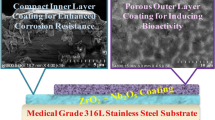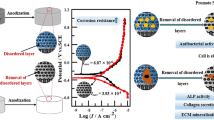Abstract
Zirconium ion implantation was performed on NiTi alloy to suppress Ni ion release as well as to improve corrosion resistance and cell-material interaction. A thicker Ni-depleted nano-scale composite layer formed after Zr implantation and the corrosion resistance was evidently increased in aspects of increased E br − E corr (difference between corrosion potential and breakdown potential) and decreased corrosion current density. 2.5/2 NiTi sample possessed the highest E br − E corr, more than 500 mV higher than that of untreated NiTi, suggesting a significant improvement on pitting corrosion resistance. Ni ion release rate of Zr–NiTi was decreased due to the depletion of Ni in the superficial surface layer and the diffusion resistance effect of the ZrO2/TiO2 nano-film. Increased surface wettability induced by increased surface roughness was obtained after Zr implantation. Zr–NiTi samples were found to be favorable to endothelial cells (ECs) proliferation, especially after 5 and 7 days culture.







Similar content being viewed by others
References
The atlas of heart disease and stroke. World Health Organization. http://www.who.int/cardiovascular_diseases/resources/atlas/en/. Accessed 16 Dec 2011.
Dotter CT. Transluminally placed coilspring endarterial tube grafts: long-term patency in canine popliteal artery. Investig Radiol. 1969;4:329–32.
Duerig T, Pelton A, Stöckel D. An overview of nitinol medical applications. Mater Sci Eng, A. 1999;273–275:149–60.
Stoeckel. nitinol medical devices and implants. Min Invas Ther & Allied Technol. 2000; 9: 81–8.
Duerig TW, Pelton AR. An Overview of Superelastic Stent Design. Mater Sci Forum. 2002;394–395:1–8.
Heintz C, et al. Corroded nitinol wires in explanted aortic endografts: an important mechanism of failure? J Endovasc Ther. 2001;8:248–53.
Wataha JC, Lockwood PE, Marek M, Ghazi M. Ability of Ni containing biomedical alloys to activate monocytes and endothelial cells in vitro. J Biomed Mater Res. 1999;45:251–7.
Kipshidze N, Dangas G, Tsapenko M. Role of the enothelium in modulaing neointimal formation. J Am Coll Cardiol. 2004;44:733–9.
Shen Y, et al. Investigation of surface endothelialization on biomedical nitinol (NiTi) alloy: effects of surface micropatterning combined with plasma nanocoatings. Acta Biomater. 2009;5:3593–604.
Plant SD, Grant DM, Leach L. Behaviour of human endothelial cells on surface modified NiTi alloy. Biomaterials. 2005;26:5359–67.
Sargeant TD, Rao MS, Koh C-Y, Stupp SI. Covalent functionalization of NiTi surfaces with bioactive peptide amphiphile nanofibers. Biomaterials. 2008;29:1085–98.
Yeung KWK, et al. Nitrogen plasma-implanted nickel titanium alloys for orthopedic use. Surf Coat Technol. 2007;201:5607–12.
Zhao TT, Li Y, Xiang Y, Zhao XQ, Zhang T. Surface characteristics, nano-indentation and corrosion behavior of Nb implanted NiTi alloy. Surf Coat Technol. 2011;205:4404–10.
Shevchenko N, Pham M-T, Maitz MF. Studies of surface modified NiTi alloy. Appl Surf Sci. 2004;235:126–31.
de Camargo EN, et al. Determination of Ni release in NiTi SMA with surface modification by nitrogen plasma immersion ion implantation. J Mater Eng Perform. 2011;20:798–801.
Zhao TT, Li Y, Zhao XQ, Chen H, Zhang T. Ni ion release, osteoblasts-materials interactions and hemocompatibility of hafnium implanted NiTi alloy. J Biomed Mater Res B. 2012;100(3):646–59.
Poon RWY, et al. Carbon plasma immersion ion implantation of nickel-titanium shape memory alloys. Biomaterials. 2005;26:2265–72.
Zhao TT, Li Y, Gao YZ, Xiang Y, Chen H, Zhang T. Hemocompatibility investigation of the NiTi alloy implanted with tantalum. J Mater Sci Mater Med. 2011;22:2311–8.
Zheng YF, Liu D, Liu XL, Li L. Enhanced corrosion resistance of Zr coating on biomedical TiNi alloy prepared by plasma immersion ion implantation and deposition. Appl Surf Sci. 2008;255:512–4.
Saldaña Laura, et al. In vitro biocompatibility of an ultrafine grained zirconium. Biomaterials. 2007;28:4343–54.
Kulakov OB, Doktorov AA, D’iakova SV. Denisov-Nikol’skiĭ IuI, Grötz KA. Experimental study of osseointegration of zirconium and titanium dental implants. Morfologiia. 2005;127:52–5.
Goodman SB, Davidson JA, Fornasier VL, Mishra AK. Histological response to cylinders of a low modulus titanium alloy (Ti–13Nb–13Zr) and a wear resistant zirconium alloy (Zr–2.5Nb) implanted in the rabbit tibia. J Appl Biomater. 1993;4:331–9.
Yu SY, Scully JR. Corrosion and passivity of Ti–13 %Nb–13 %Cr in comparison to other biomedical implant alloys. Corrosion J. 1997;53(12):965–76.
Standard test method for conducting cyclic potentiodynamic polarization measurements to determine the corrosion susceptibility of small implant devices, ASTM-F 2129. 2008.
Biological evaluation of medical devices-Part 12: sample preparation and reference materials. ISO 10993-12:2004.
Owens DK, Wendt RC. Estimation of the surface free energy of polymers. J Appl Polym Sci. 1969;13:1741–7.
Kubicek JD, Brelsford S, Ahluwalia P, Leduc PR. Integrated lithographic membranes and surface adhesion chemistry for three-dimensional cellular stimulation. Langmuir. 2004;20:11552–6.
Dalby MJ, Riehle MO, Sutherland DS, Agheli H, Curtis AS. Use of nanotopography to study mechanotransduction in fibroblasts—methods and perspectives. Eur J Cell Biol. 2004;83:159–69.
Zhu B, Zhang Q, Lu Q, Xu Y, Yin J, Hu J, Wang ZG. Nanotopographical guidance of C6 glioma cell alignment and oriented growth. Biomaterials. 2004;25:4215–23.
Tan L, Crone WC. Effects of methane plasma ion implantation on microstructure and wear resistance of NiTi shape memory alloys. Thin Solid Films. 2005;472:282–90.
Yamamura Y, Tawara H. Energy dependence of ion-induced sputtering from monatomic solids at normal incidence. At Data Nucl Data Tables. 1996;62:149–253.
Levintant-Zayonts N, Kucharski S. Surface characterization and wear behavior of ion implanted NiTi shape memory alloy. Vacuum. 2009;83:S220–3.
Chu CL, Guo C, Sheng XB, Dong YS, Lin PH, Yeung KWK, Chu PK. Microstructure, nickel suppression and mechanical characteristics of electropolished and photoelectrocatalytically oxidized biomedical nickel titanium shape memory alloy. Acta Biomater. 2009;5:2238–45.
Shabalovskaya SA, Anderegg JW. Surface spectroscopic characterization of TiNi nearly equiatomic shape memory alloys for implants. J Vac Sci Technol A. 1995;13:2624–32.
Frankel GS. Pitting corrosion, corrosion: fundamentals, testing, and protection, vol. 13A. ASM International: ASM Handbook; 2003. p. 236–41.
Yeung KWK, et al. In vitro and in vivo characterization of novel plasma treated nickel titanium shape memory alloy for orthopedic implantation. Surf Coat Technol. 2007;202:1247–51.
Borgs C, De Coninck J, Kotecký R, Zinque M. Does the roughness of the substrate enhance wetting? Phys Rev Lett. 1995;74:2292–4.
Cai KY, Bossert J, Jandt KD. Does the nanometre scale topography of titanium influence protein adsorption and cell proliferation? Colloid Surface B. 2006;49:136–44.
Arima Y, Iwata H. Effect of wettability and surface functional groups on protein adsorption and cell adhesion using well-defined mixed self-assembled monolayers. Biomaterials. 2007;28:3074–82.
Acknowledgments
This work is supported by National Natural Science Foundation of China (NSFC), No. 50971007 and 51171009. Yan Li acknowledges the Program for New Century Excellent Talents in University (NCET-09-0024).
Author information
Authors and Affiliations
Corresponding author
Rights and permissions
About this article
Cite this article
Zhao, T., Li, Y., Xia, Y. et al. Formation of a nano-pattering NiTi surface with Ni-depleted superficial layer to promote corrosion resistance and endothelial cell-material interaction. J Mater Sci: Mater Med 24, 105–114 (2013). https://doi.org/10.1007/s10856-012-4777-1
Received:
Accepted:
Published:
Issue Date:
DOI: https://doi.org/10.1007/s10856-012-4777-1




